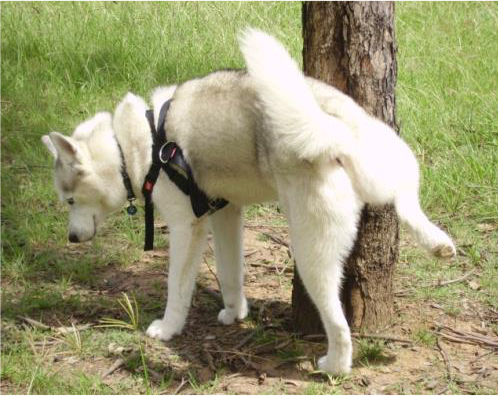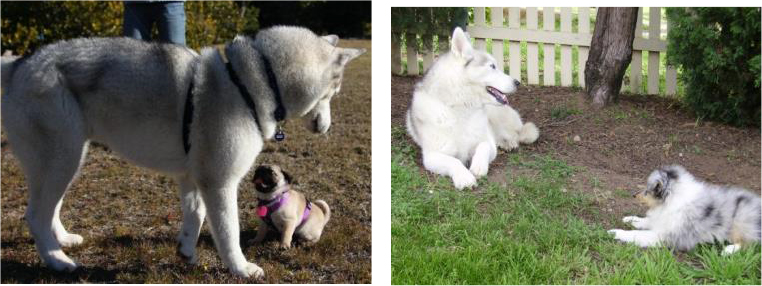The Art of Introducing Dogs (5 page)
Read The Art of Introducing Dogs Online
Authors: Louise Ginman

Preparation for you before you get started
If you haven’t already done so, get your dog behavioural trainer on board so that they can assist you to get the best outcome for your introduction. Good and experienced dog behavioural trainers are trained to recognise dog body language to effectively manage and train dogs. During introductions, it is vital that either you or an experienced trainer can correctly ‘read’ what the dogs are saying, as failure to do so could quickly lead to a fight or escalation in tension. At minimum it could lead to you thinking the introduction was a success when really one or both of the dogs were saying “I don’t really like you, please go away”. Having been a dog park user for 9 years, I commonly hear owners commenting that their dog is just playing, when what I am seeing is one dog being bullied by another and the bully failing to respect the other dogs signals to back off—these signals are termed distance increasing signals. The owners are always then surprised when the ‘play’ ends up with one dog reacting aggressively to the other. The so called ‘aggressive dog’ was the one being bullied and who eventually resorted to defensive behaviour — e.g. a snarl, snap or lunge, once all of its ‘back’ off or distance increasing signals had been ignored by the other dog.
Therefore to arm you with knowledge of dog behaviour please go to the resources section to find a recommended list of resources that will increase your dog body language knowledge. The supplied list is by no means all that is available on the subject but will give you the vital information required to be able conduct successful introductions.
______________
1
Play style information taken from Bennett and Briggs (2008) — see resources section.
2
See Dr Jean Donaldson’s book ‘The Culture Clash’ Chapter 3 for more information on Bite Inhibition.
3
The information presented about bite inhibition and fight-bite ratio has been taken from Dr Ian Dunbar’s book ‘Before and After getting your puppy’ For a more thorough look at these subjects, please read the appropriate chapters in Dunbar’s book.
Chapter 2
Performing the introduction

Now that we have established some of the major considerations, done our research, assessed our dogs and the new dog, it is finally time to begin the introductions. All or most of the introductions can be done on either your days off or after work hours, although depending on your situation, you may need to take a day off here and there to do all the introductions. If bringing a new dog/puppy into your home, I recommend taking at least 3 weeks off work in order to settle the new dog with your current dog/s into your home. The more time you can spend at home settling the dogs, the better you can train, teach the house rules and manage any problems that arise.
If you are adding a new dog into a play, walking or social group, you can space the introductions out over weeks or months. Since these dogs will only be spending shot periods of time together i.e. while you go for a walk or play at the park etc., there is less need to take any time off work to achieve a smooth introduction.
There is a basic procedure to follow for any introduction. Depending on the personalities concerned, the speed of the introduction can be tailored to cater for each dog. The ideal introduction is one where we have planned each step out and given our dog up to 7 days (more would be great) of slow introductions before bringing the newcomer home. Often there is no planning and the whole introduction is attempted in one day. I do not recommend this approach to introductions. My recommendation is to plan and proceed slowly; it really will be worth the time taken. You will also need the assistance of a friend or your dog behavioural trainer for the majority of the introduction process. Each dog requires their own handler. You should always handle your current dog with your friend or trainer handling the new dog.
Appendix A
has recommended introduction schedules for each type of introduction. The introductions described here assume that you are introducing one current dog to a new dog or puppy.
If you already have multiple dogs, you should aim to do one on one introductions with each of your current dogs to the new dog/puppy before slowly putting all of the dogs together so that the new dog or pup is not overwhelmed. Naturally this will take longer to achieve as there are more dogs to work with. Depending on the personalities of each of your current dogs you can begin with introduction of your lowest status dog and work your way up to the most assertive/confident or alternatively, work from the top down. Both ways have benefits. New dogs welcomed into the ‘pack’ by the most assertive/confident dog may be more easily accepted by the remainder of the dogs. Alternatively, beginning with the least assertive/confident dog can work well and may be less stressful for the new dog. See
appendix A
for a recommended introduction schedule for homes that contain multiple dogs.
This means that neither dog has spent any length of time in the chosen area. It may be an exercise area at the pound or shelter or fully fenced park that is unfamiliar to both. Your dog and the new dog need to feel comfortable and calm within the area chosen for the introduction.
Shelters
can be stressful places for pet dogs as there is the overwhelming scent of numerous other dogs and often a lot of noise from barking. Before meeting the new dog, allow your dog to calm and settle. Walk your dog around for as long as is needed until she is calm and responding to you and or taking treats from you. A stressed dog will usually fail to respond and food will be the last thing on their mind. If your dog is stressed, she may also show hyper vigilance, be hyperactive, clingy or be quiet and withdrawn or any combination of these behaviours. If your dog does not calm down within 30 to 60 minutes, go home and return another day following the same procedure. Stress in either dog could affect the outcome. I am sure we all know someone (a friend or colleague) who when stressed, gets ‘snappy’ or behaves differently. Your dog is no different, so it is important to let them calm before proceeding.

Wait for your dog to be calm and responding to you before proceeding with the introduction. The dog on the left is focussed and relaxed. He has an open mouth and is watching his owner. The dog on the right is stressed. She is scanning the environment, has a raised paw and tense mouth. This dog is not ready to participate in an introduction.
Never underestimate scent for dogs. Dogs use scent like we use our eyes, so take advantage of this as the first part of any introduction.
While you are working to de-stress your dog, the prospective dog should be in the exercise area, de-stressing but also leaving its scent. Once your dog is ready, remove the prospective dog and allow your dog to explore the exercise area off lead. This allows your dog to become familiar with the area but also start to become familiar with the new dog’s scent. While sniffing the scent, is your dog becoming rigid, standing tall, mouth tense and scanning for the threat OR taking in the scent but remaining relaxed, maybe marking over it but then moving on to the next smell? Beware if your dog is tense when smelling the new dog’s smell — although in a shelter where numerous dogs go into the yards each day, it may not be the new dog’s smell that made your dog tense. Either way do not proceed until your dog has calmed down again. Remove your dog and allow the prospective dog to check out your dog’s scent as well, again looking for reactions.

This dog is leaving his scent on a tree in the local dog park. Scent marking is for the benefit of both the dog leaving the scent and other dogs that ‘read’ or smell the scent.
The same procedure can be done in a
fully fenced park
using two handlers. Keep dogs out of sight of each other initially so that arousal levels are kept low. Allow one dog to run off lead in the fenced park leaving scent marks to his hearts’ content while the other dog is off having a lovely walk out of sight. Then do a swap and watch the reaction from your dog to the newcomer and then swap again to watch the reaction of the newcomer to your dog. In all cases, the dogs should show mild interest in the scent but maintain loose relaxed bodies and mouths and keep moving and exploring.
For
puppies,
you can’t go to a park due to the risk of disease, but you can set up a series of meetings at the breeder’s home if they live within easy driving distance. For this reason, it is preferable to get a puppy from a breeder that lives close to you so that you and your dog can visit several times before taking the puppy home. If you found a breeder that lives in another state or a long distance from your home, you have no way of assessing the parents or puppy first hand nor know how your dog will react to the puppy and vice versa. Puppies are not born as blank slates. They come with inherited temperament traits and early learning that may affect their long term behaviour and therefore the future with you and your dog/s.
It is OK and in fact preferable, that the puppy is on home ground (the breeder’s home) otherwise it can be way too scary for the puppy to suddenly be faced with the loss of mum and siblings, brand new environment plus a big scary unfamiliar adult dog. Again allow your dog to sniff around the yard on his own to give him time to relax before introducing the puppy. You should plan to visit the puppy several times this way before taking puppy home. Puppy introductions done in this way should be fairly easy and straight forward. See
Appendix A
for a puppy introduction schedule

Off lead puppy introductions should be done at the breeders’ home. Plan for several short introductions once the pup is 7 weeks of age so that both are familiar with each other before you bring the pup home.

